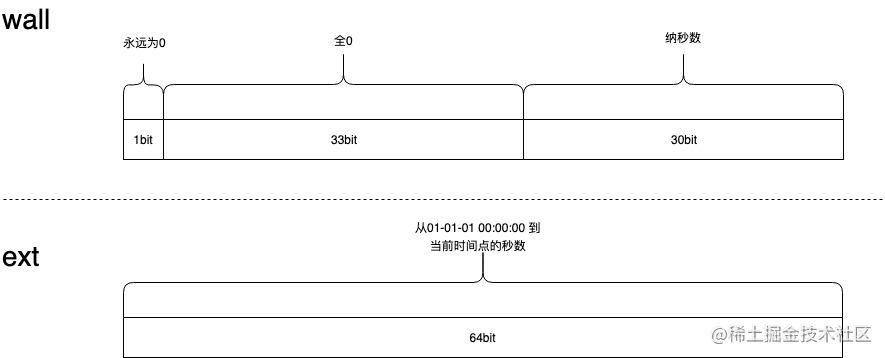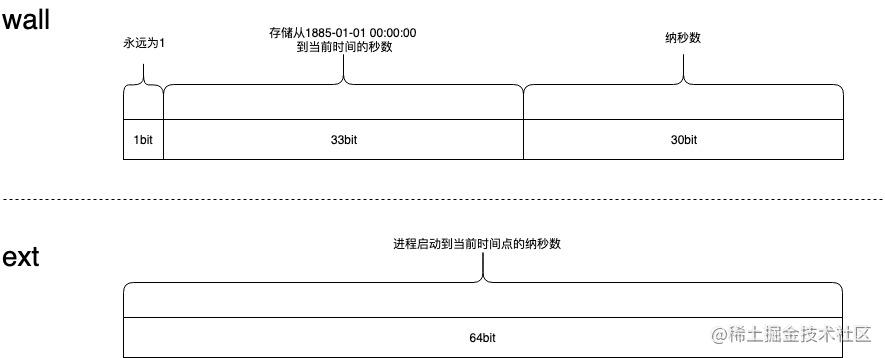问题背景:程序员需要相信的关于时间的谎言 时间可以倒流
golang社区有关于此问题的讨论 https://github.com/golang/go/issues/12914
因为程序员相信时间不会倒流,就是记录下当前时间timeA,然后程序处理一些事情后,再记录当前时间timeB,程序员认为 timeB - timeA 一定是正数,因为现在的时间永远发生在过去时间之后。按照这种想法写程序有时候程序里就可能埋藏着bug。但实际上是可以为负数的,因为有闰秒的存在。
闰秒是偶尔运用于协调世界时(UTC)的调整,经由增加或减少一秒,以消弥精确的时间(使用原子钟测量)和不精确的观测太阳时 (称为UT1),之间的差异。这会由于地球自转的不规则和长期项的地球自转减慢而有所不同。UTC标准时间广泛用于国际计时,并在大多数国家用作民用时的参考,它使用精确的原子时,因此,除非根据需要将其重置为UT1,否则将超前运行在观测到的太阳时。闰秒的存在就是为了提供这样的调整。
因为地球的旋转速度会随着气候和地质事件的变化而变化,因此UTC的闰秒间隔不规则且不可预知。每个UTC闰秒的插入,通常由国际地球自转服务(IERS)提前约六个月决定,以确保UTC和UT1读数之间的差值永远不会超过0.9秒。
这种做法已被证明具有破坏性,特别是在二十一世纪,尤其是在依赖精确时间戳或时间关键程序控制的服务中。相关国际标准机构一直在讨论是否继续这种做法。
从1972年到2020年,平均每21个月就插入一次闰秒。然而,间隔是非常不规则的,而且明显在增加:在1999年1月1日至2004年12月31日的六年中没有闰秒,但在1972-1979年的八年中有九个闰秒。
因为地球的自转速度的变化不规则,导致闰秒的间隔不规则。事实上,地球自转在长期上是不可预测的(地球自转速度减慢的主要原因是潮汐摩擦,改变了地球的惯性矩,由于角动量守恒而影响了自转速率。一次大的海啸也会改变地球的自转速率从而改变一天的时间),这也解释了为什么闰秒通常只提前六个月宣布。
由于已经存在两个没有闰秒的时间,国际原子时(TAI)和全球定位系统(GPS)时间。例如,电脑可以使用这些时间,并根据需要转换为UTC或本地民用时间进行输出。2022年11月,在第27届国际计量大会上,投票决定到2035年取消闰秒。
下面回到 Golang 上来。
Now方法返回当前的时间,其中用到了runtime中的now()函数,该函数对应的runtime中的time_now方法。而walltime 和 nanotime 是以汇编实现的。汇编中用 vdso call 来获取到当前的时间信息。
func Now() Time {
sec, nsec, mono := now()
mono -= startNano
sec += unixToInternal - minWall
if uint64(sec)>>33 != 0 {
return Time{uint64(nsec), sec + minWall, Local}
}
return Time{hasMonotonic | uint64(sec)<<nsecShift | uint64(nsec), mono, Local}
}hasMonotonic 表示是否有单调递增的时钟。
//go:linkname time_now time.now
func time_now() (sec int64, nsec int32, mono int64) {
sec, nsec = walltime()
return sec, nsec, nanotime()
}// func walltime() (sec int64, nsec int32)
TEXT runtime·walltime(SB),NOSPLIT,$24-12
MOVD RSP, R20 // R20 is unchanged by C code
MOVD RSP, R1
MOVD g_m(g), R21 // R21 = m
// Set vdsoPC and vdsoSP for SIGPROF traceback.
// Save the old values on stack and restore them on exit,
// so this function is reentrant.
MOVD m_vdsoPC(R21), R2
MOVD m_vdsoSP(R21), R3
MOVD R2, 8(RSP)
MOVD R3, 16(RSP)
MOVD $ret-8(FP), R2 // caller's SP
MOVD LR, m_vdsoPC(R21)
MOVD R2, m_vdsoSP(R21)
MOVD m_curg(R21), R0
CMP g, R0
BNE noswitch
MOVD m_g0(R21), R3
MOVD (g_sched+gobuf_sp)(R3), R1 // Set RSP to g0 stack
noswitch:
SUB $16, R1
BIC $15, R1 // Align for C code
MOVD R1, RSP
MOVW $CLOCK_REALTIME, R0
MOVD runtime·vdsoClockgettimeSym(SB), R2
CBZ R2, fallback
// Store g on gsignal's stack, so if we receive a signal
// during VDSO code we can find the g.
// If we don't have a signal stack, we won't receive signal,
// so don't bother saving g.
// When using cgo, we already saved g on TLS, also don't save
// g here.
// Also don't save g if we are already on the signal stack.
// We won't get a nested signal.
MOVBU runtime·iscgo(SB), R22
CBNZ R22, nosaveg
MOVD m_gsignal(R21), R22 // g.m.gsignal
CBZ R22, nosaveg
CMP g, R22
BEQ nosaveg
MOVD (g_stack+stack_lo)(R22), R22 // g.m.gsignal.stack.lo
MOVD g, (R22)
BL (R2)
MOVD ZR, (R22) // clear g slot, R22 is unchanged by C code
B finish
nosaveg:
BL (R2)
B finish
fallback:
MOVD $SYS_clock_gettime, R8
SVC
finish:
MOVD 0(RSP), R3 // sec
MOVD 8(RSP), R5 // nsec
MOVD R20, RSP // restore SP
// Restore vdsoPC, vdsoSP
// We don't worry about being signaled between the two stores.
// If we are not in a signal handler, we'll restore vdsoSP to 0,
// and no one will care about vdsoPC. If we are in a signal handler,
// we cannot receive another signal.
MOVD 16(RSP), R1
MOVD R1, m_vdsoSP(R21)
MOVD 8(RSP), R1
MOVD R1, m_vdsoPC(R21)
MOVD R3, sec+0(FP)
MOVW R5, nsec+8(FP)
RETconst (
hasMonotonic = 1 << 63
maxWall = wallToInternal + (1<<33 - 1) // year 2157
minWall = wallToInternal // year 1885
nsecMask = 1<<30 - 1
nsecShift = 30
)若晚于2157年,Time结构体中的wall和ext的格式是下面这样的:
if uint64(sec)>>33 != 0 {
return Time{uint64(nsec), sec + minWall, Local}
}返回的Time的第一个参数是wall,第二个参数是ext
type Time struct {
wall uint64
ext int64
loc *Location
}
若早于2157年,Time结构体中的wall和ext的格式是下面这样的:(现在2022年12月就是下面的数据格式,实际上上面的情况永远不可能存在,因为golang不可能存活100多年并且time包不会不发生变化100多年)
return Time{hasMonotonic | uint64(sec)<<nsecShift | uint64(nsec), mono, Local}返回的Time的第一个参数是wall,第二个参数是ext

下面的Sub方法返回的是两个时间的间隔。Sub方法的代码可见计算两个时间的间隔是通过ext计算的,不是通过wall计算的,而ext在2157年之前ext是但单调递增的。
golang在 1.9版本 增加了透明单调递增时间(transparent monotonic time)支持。所以在之前的版本由于wall(墙上的挂钟)增加了闰秒会因为不是单调递增从而引入时间倒流的bug。
func (t Time) Sub(u Time) Duration {
if t.wall&u.wall&hasMonotonic != 0 {
te := t.ext
ue := u.ext
d := Duration(te - ue)
if d < 0 && te > ue {
return maxDuration // t - u is positive out of range
}
if d > 0 && te < ue {
return minDuration // t - u is negative out of range
}
return d
}
d := Duration(t.sec()-u.sec())*Second + Duration(t.nsec()-u.nsec())
// Check for overflow or underflow.
switch {
case u.Add(d).Equal(t):
return d // d is correct
case t.Before(u):
return minDuration // t - u is negative out of range
default:
return maxDuration // t - u is positive out of range
}
}增加秒数的addSec方法,比较时间先后的After,Before,Equal都分 2157前还是后。
若程序运行在2157年之前,且用的golang版本是1.9之后的版本,那可以放心,不会引入因为闰秒导致的时间倒流的bug。
func (t *Time) addSec(d int64) {
if t.wall&hasMonotonic != 0 {
sec := int64(t.wall << 1 >> (nsecShift + 1))
dsec := sec + d
if 0 <= dsec && dsec <= 1<<33-1 {
t.wall = t.wall&nsecMask | uint64(dsec)<<nsecShift | hasMonotonic
return
}
// Wall second now out of range for packed field.
// Move to ext.
t.stripMono()
}
// Check if the sum of t.ext and d overflows and handle it properly.
sum := t.ext + d
if (sum > t.ext) == (d > 0) {
t.ext = sum
} else if d > 0 {
t.ext = 1<<63 - 1
} else {
t.ext = -(1<<63 - 1)
}
}
func (t Time) After(u Time) bool {
if t.wall&u.wall&hasMonotonic != 0 {
return t.ext > u.ext
}
ts := t.sec()
us := u.sec()
return ts > us || ts == us && t.nsec() > u.nsec()
}
func (t Time) Before(u Time) bool {
if t.wall&u.wall&hasMonotonic != 0 {
return t.ext < u.ext
}
ts := t.sec()
us := u.sec()
return ts < us || ts == us && t.nsec() < u.nsec()
}
func (t Time) Equal(u Time) bool {
if t.wall&u.wall&hasMonotonic != 0 {
return t.ext == u.ext
}
return t.sec() == u.sec() && t.nsec() == u.nsec()
}下一个版本的的Compare方法:
即将于2023年2月发布的Golang 1.20版本新增了Compare方法。因为After,Before,Equal方法相当于<, >,=。还没有个<=. >=方法,于是新增了Compare方法。
// Compare compares the time instant t with u. If t is before u, it returns -1;
// if t is after u, it returns +1; if they're the same, it returns 0.
func (t Time) Compare(u Time) int {
var tc, uc int64
if t.wall&u.wall&hasMonotonic != 0 {
tc, uc = t.ext, u.ext
} else {
tc, uc = t.sec(), u.sec()
if tc == uc {
tc, uc = int64(t.nsec()), int64(u.nsec())
}
}
switch {
case tc < uc:
return -1
case tc > uc:
return +1
}
return 0
}其他time相关的具体的时间相关的函数(分布在time.go local.go zoneinfo.go)很多,都比较简单,不一一分析了。
待以后再分析timer和ticker相关的代码(实际上timer和ticker相关的源码已经不属于time包了,在runtime包里)。
转载请注明来源,欢迎指出任何有错误或不够清晰的表达。可以邮件至 backendcloud@gmail.com

